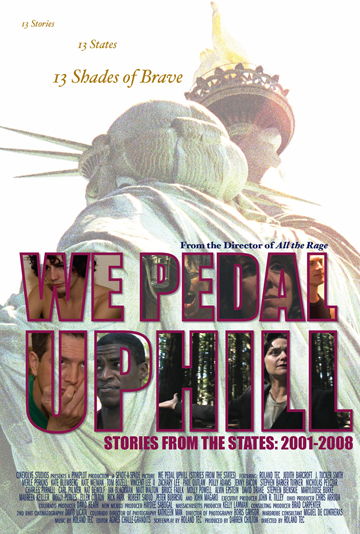
Last time, in the midst of indulging my passion for telling details, I forgot to tell you about my recent holiday encounter with the camel pictured above. If this isn’t a story where the specifics provide all of the characterization needed…well, I let you judge for yourself. While you’re at it, why not continue our ongoing tradition of figuring out what editorial tweaks could improve the story?
Curly the camel, Moe the donkey, and, to mix Christmas traditions as thoroughly as possible, Donner the reindeer have been on tour together, strip mall manger scene after strip mall manger scene, since they were just small, furry refugees from the petting zoo where they were born. Despite their years of entertainment experience, my local nursery — plants, not animals — has plastered the six-foot wire fence around their enclosure with warnings to wreath-buying patrons about keeping their fingers, gloves, hat pom-poms, scarf tassels, and bundled-up infants away from Curly’s long reach, Moe’s strong teeth, and Donner’s oddly-shaped antlers.
I watched scores of children fling hay at them, shouting, “Hey, Reindeer!” (or “Hey, Dog,” from those who had never seen a miniature donkey before), but the trio just stood there, blinking slowly, eyes glazed. Most of the time, the parents would intervene before the children grew too frustrated with their passivity and rushed the pens.
One small pink-clad screamer simply would not leave the animals alone, however. She kicked at the metal fencing, bellowing words I was a surprised a kindergartener would be able to use correctly in a sentence. When she picked up a rock, I wandered over to the fence to distract her with a hastily-constructed fairy tale about our barnyard friends. And camels.
Almost immediately, a bulbous man in shorts and a t-shirt appeared by my side. Despite ambient cold that left our breath visible, his exposed arms and legs were not even goose-bumped. “Come over here,” he barked at the little girl, dragging her along the fence until they were directly in front of Curly.
Was he going to make her apologize to the camel? I doubted Curly would appreciate it.
Releasing the quivering child, the man — whose clothing, I noticed, was emblazoned with advertisements for a local band and Nike, not the nursery — abruptly reached up and over the chain-link fence, snapping his fingers. Placidly, Curly dipped his head, extending his hyper-mobile lips toward the hand.
Curious to hear what happened next, aren’t you? That’s a good indicator that a scene is paced well. See how selecting those details carefully, as we discussed yesterday, as well as not over-burdening the text with explanations, can increase suspense while simultaneously moving the plot along?
So why, I ask you, would our old pal, Millicent the agency screener, have stopped reading part-way through paragraph #2? Because, I assure you, most Millicents would have: one of her most notorious pet peeves has reared its ugly head here.
If you pointed out that the narration switched tenses between the first and second paragraphs, congratulations! Paragraph #1 is in the present tense; paragraph #2 is in the past. Submissions and contest entries do that all the time. Sometimes, they even switch back within a paragraph or two.
Already, I can spot some raised hands out there. “But Anne,” adherents of variable tenses point out, and with some reason, “Paragraph #1 describes an ongoing condition, while paragraph #2 on focuses upon one-time events. Doesn’t that mean that the tense choices here are appropriate, or at least defensible?”
Good question, tense-switchers. Remember how I mentioned earlier in this series on self-editing that professional readers — agents, editors, contest judges, writing teachers, etc. — are trained to spot redundancies in a manuscript? They’re also taught to leap upon inconsistencies.
In other words, Millicent is likely to assume that the change of tense is not the result of well thought-out authorial choice, but simply a mistake that did not get caught in the proofreading process. And, like other commonly-made errors, the tense inconsistency may well jar her out of the flow of the story. Next!
You habitual tense-switchers are not particularly happy with that answer, are you? “Okay, so she’s detail-oriented, but this isn’t a writing mistake; this is a stylistic choice. So why would Millicent be annoyed by it?”
On its face, your logic is pretty sound, tense-switchers: it would indeed be possible, within the context of a civil conversation between author and reader, to justify the tense choices in the example above. A writer could very likely win an argument with, say, a writing teacher, critique group, or even an editor about keeping the switch in the text. But that doesn’t mean it would be a good idea to submit pages with tense inconsistencies to Millicent — or to her aunt Mehitabel the contest judge, for that matter.
Why, you ask? Long-time readers of this blog, chant it with me now: because the writer is seldom present when an agency screener, editorial assistant, or contest judge encounters his manuscript for the first time. Successful manuscripts and contest entries are thus those that do not require additional verbal explanation.
So even if the writer is technically correct, if a tense switch seems unjustified to Millicent — if it appears to be, say, an incomplete revision between a manuscript originally in the present tense and a subsequent draft in the past, or vice-versa — that’s usually the ball game. Why risk it?
Especially when, as in this case, making the tense consistent does not detract at all from either the meaning or the voice of the section. Lookee:
Curly the camel, Moe the donkey, and, to mix Christmas traditions as thoroughly as possible, Donner the reindeer had been on tour together, strip mall manger scene after strip mall manger scene, since they were just small, furry refugees from the petting zoo where they were born. Despite their years of entertainment experience, my local nursery — plants, not animals — plastered the six-foot wire fence around their enclosure with warnings to wreath-buying patrons about keeping their fingers, gloves, hat pom-poms, scarf tassels, and bundled-up infants away from Curly’s long reach, Moe’s strong teeth, and Donner’s oddly-shaped antlers.
I watched scores of children fling hay at them, shouting, “Hey, Reindeer!” (or “Hey, Dog,” from those who had never seen a miniature donkey before), but the trio just stood there, blinking slowly, eyes glazed. Most of the time, the parents would intervene before the children grew too frustrated with their passivity and rushed the pens.
That’s as painless a revision as you’re ever likely to see, folks. It just requires a good proofreading eye to catch — and need I even add that this variety of inconsistency is easiest to catch if one reads one’s submission or contest entry IN HARD COPY, IN ITS ENTIRETY, and OUT LOUD?
I thought not. Let’s move on with the story, to see if we can catch any other Millicent-displeasers.
Delicately, politely, as if he were extracting an egg from beneath a mother hen, Curly took the man’s fingers into his gargantuan mouth. The hand did not budge. Curly paused meditatively for a few seconds, tasting, then sucked the hand into his mouth up to the elbow.
Instinctively, I took a step toward the child: if the object lesson about the dangers of violating animals’ personal space was about to go horribly awry, the least I could do was shield her from seeing the bloody denouement.
The man waved me back with his free hand. “See, Tanya?” he told the saucer-eyed girl. “They like people. If you treat them nicely, they’ll treat you nicely.”
“That’s right, sweetie.” A stringy-haired woman called from the nearby wreath display. “Be nice to the animals, and they’ll never hurt you.”
“You just have to learn what they like.” A helpful bystander kicked a crate toward the man’s feet, so he could follow his arm skyward. “Camels love sucking on things.”
Mentally, I began taking notes, in preparation for my inevitable testimony at a lawsuit. “I think she’s got the point. Maybe it’s time to back off now?”
Okay, what’s the problem this time? Hint: it’s even more subtle than the last.
No? What about all of that redundancy in the dialogue?
That made some of you do a double-take, didn’t it? “But Anne,” several exclaim, “that’s how people talk in real life! You’re not gearing up to tell us that Millicent finds realistic dialogue annoying, are you?”
Um, sort of. At least the parts of real-life speech that are redundant. Or not germane to what’s going on. Or just plain boring.
Oh, how often writers forget that real-life dialogue generally does not reproduce well on the page! If I had a nickel for every time I’ve heard a writer say, “But s/he really said that!” or “But that’s what people really sound like!” I would buy my own Caribbean island and send the entire Little Old Lady Mafia on annual vacations there.
Do I see a raised hand or two out there? “But Anne,” I hear some of you protest, “haven’t we already talked about this in this series? Just as absolutely faithful recreations of real-life events often don’t translate well into fiction, neither does most dialogue. Am I missing a nuance here?”
Perhaps one: aspiring writers also tend to forget that real-life dialogue is seldom character-revealing — and thus reproducing it in a manuscript will often not convey as much about a character as we sometimes expect.
Or, as Millicent likes to put it, “Move ON with it!”
Take, for instance, the oh-so-common writerly habit of placing the speeches of an annoying co-worker, relative, ex-lover, nasty dental receptionist, etc. into fictional mouth of a minor novel character as a passive-aggressive form of revenge. (Come on, every writer’s at least thought about it.) To a professional reader, the very plausibility of this type dialogue often labels it as lifted from real life:
“Oh, wait a minute, Sarah.” Pausing in mid-gossip, Theresa picked up the overturned plastic cup before anyone else could step on it, placing it neatly on the dining hall checker’s desk.
Dina the checker glared at it as if it was covered in baboon’s spit. “Don’t you dare leave your trash on my desk. Do you think I have nothing to do but clean up your messes?”
“It was on the floor,” Theresa stammered awkwardly.
“Don’t you give me your excuses.” Dina grew large in her seat, like a bullfrog about to emit a great big ribbet. “You walk that right over to the trash can. Now, missie.”
“I thought you had dropped it.”
“Go!”
“I’ll save you a seat,” Sarah offered, embarrassed.
Inwardly seething and repenting of her Good Samaritanism, Theresa obediently gave up her place in the block-long lunch line in order to take the walk of shame to the garbage receptacles on the far end of the dining hall. How quickly a good mood could evaporate.
Tell me: what about this scene would tip off Millicent that this really happened, and that Dina is a character from the author’s past? And why would her being able to tell this be a liability? Why, in fact, would Millicent be surprised if Dina ever showed later in the book any side other than the touchy one displayed here — or, indeed, if she ever appeared again?
Actually, that was a trick set of questions, because the answer to each part is the same: because the narrative doesn’t provide enough motivation for the intensity of Dina’s response. Fairly clearly, the writer doesn’t think that any such explanation is necessary. That’s usually an indication that the writer has a fully-formed mental image (negative, in this case) of the villain in question.
In other words, this is a rather subtle manifestation of the telling, rather than showing phenomenon: because the writer experienced this exchange as nasty because Dina was nasty, she has assumed that the reader will perceive it that way as well.
But without more character development for Dina — or indeed, some indication of whether this kind of insistence was typical for her — the reader isn’t really getting enough information to draw that conclusion…or any other. It’s just an anecdote.
Most self-editing writers wouldn’t notice this narrative lack — any guesses why?
If you said it was due to the fact that his memory of Dina the real person is so strong, run out and get yourself a chocolate sundae with jimmies on top. In his mind, her character is so well established that he can just write about her, rather than helping the reader get to know her.
The other tip-off that this was a real exchange, in case you were wondering, is that Theresa is presented as a completely innocent victim of an unprovoked attack. The pure villain vs. completely blameless protagonist is a dead giveaway that dear self is concerned.
And yes, I WAS darned annoyed when Dina — in real life, a very nice woman named Ellen who happened to be having a spectacularly bad day — misinterpreted my act of good citizenship. But if I crave well-deserved vindication from the total strangers who might conceivably read this story, I’m going to have to do quite a bit more character development.
Not to mention integrating the incident into the storyline well enough that it’s actually interesting to read.
Of course, we want to be true-to-life in our dialogue: as Virginia Woolf wrote, “fiction must stick to the facts, and the truer the facts, the better the fiction.” But let’s not forget that in order to maintain a reader’s interest, a book has to have entertainment value, too — and that however amusing a verbal tic might be in person, repetition is often annoying in on the page.
This is especially true when a character is tired, angry, or in pain, I notice: all of a sudden, the dialogue sounds as though all of the characters are trapped in one of those interminable Samuel Beckett plays where the people are doomed to move immense piles of sand from one end of the stage to the other with teaspoons. See if this dialogue sounds familiar, theatre-goers:
A: “Oh. You’re home.”
B: (nursing the thumb the elephant trod upon in the last scene) “Yeah.”
A: “Have a nice day?”
B: “Um-hm.”
A: “I was cleaning out the attic today, and I came across that picnic blanket we used when we went out to Goat’s Rock Beach to scatter Father’s ashes. How it rained that day, and then the sun broke out as if Father and God had joined forces to drag the clouds aside to smile upon our picnic.”
B: “Yeah. “
A: “Ham sound good for dinner?”
B: “Yeah.”
A good third of the dialogue Millicent sees runs approximately like this. Understand now why she might become just a tad touchy at the sight of dialogue that provides neither character development nor moves the plot along?
As a general rule of thumb, I like to flag any piece of dialogue that contains more than one use of yeah, really, yes, no, uh-huh, or, often, um. Almost invariably, these are an indication that the dialogue could either be tightened considerably or needs to be pepped up.
Similarly, anyway and however in dialogue are pretty reliable flares, indicating that the speaker has gotten off-topic and is trying to regain his point — thus warning the manuscript reviser that perhaps this dialogue could be tightened so that it stays ON point.
My fictional characters tend to be chatty (dialogue is action, right?), and I was once taken to task for it by a fairly well-known writer of short stories. She had just managed to crank out her first novella — 48 pages typeset, so possibly 70 in standard manuscript format — so perhaps unsurprisingly, she found my style a trifle generous with words.
“Only show the dialogue that is absolutely necessary,” she advised me, “and is character-revealing.”
Hard to argue with that, eh? Yet, like most writers receiving critical feedback, I fought it at first. Since the dialogue in my advisor’s published works has seldom, if ever, strayed beyond three lines, regardless of situation or character, I was not particularly inclined to heed this advice — have you noticed how often it’s true that established writers with little or no teaching background spout aphorisms that all boil down to “Write as I do”? — but I have to say, it has been useful in editing, both for others’ work and my own.
I can even derive an axiom of my own from it: if a person said it in real life, think twice before including it. If it isn’t either interesting or character-revealing, does it really need to be there?
One more insight, then I’m done for the day: you’ve been having just a little trouble paying attention to my arguments, haven’t you? Some part of your mind has been distracted, wondering what happened to the arm in the camel’s mouth?
That, my friends, is how Millicent — and most other readers, professional and non-pro alike — feels when an interesting one- or two-paragraph teaser, the kind that aspiring writers so love placing within italics, gives way to an apparently or only tangentially unrelated second scene. “Hey!” Millicent cries, spitting out her mouthful of scalding latte, “what happened to that darn interesting plot I’d gotten absorbed in? What’s this writer trying to do, hook me with something exciting, then drop me into a comparatively mundane storyline?”
Let’s be honest, folks: that’s precisely what most writers who use this trick are trying to do. Professional readers are wise to it by now.
Remember, part of being a good storyteller involves knowing when to relieve the suspense. In the case of my camel story, now would be a good time.
“Give me a boost,” the man asked calmly, but his eyes were beaming panic over his daughter’s head. Curly’s lips were exploring the first few inches of his t-shirt sleeve.
The crate-kicker and I complied. With his uneaten hand, he began tickling the camel’s lips, rubbing the gums as if he were a mammalian dentist. Curly face elongated, as though he were going to sneeze. A loud pop, a slurp, and the man was freed.
He strutted his way down from the crate. “See?” he told the girl. “If you know what you’re doing, they won’t hurt you.”
“Yes, Daddy,” she whispered, staring aghast at his friction-reddened arm.
The moral, if I may venture one: just because something seems like a good idea at first blush doesn’t mean that it’s worth stubbornly adhering to it. One of the keys to successful self-editing is flexibility.
That, and keeping any parts of your body involved in typing out of animals’ mouths. Keep up the good work!





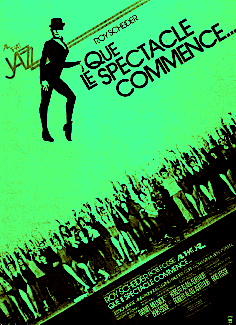
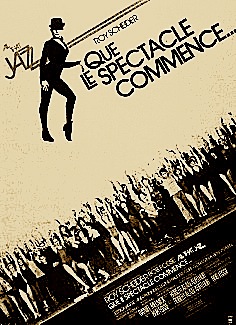
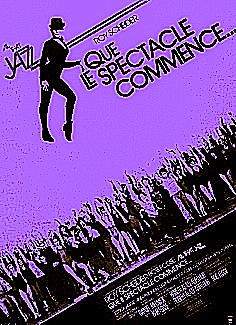


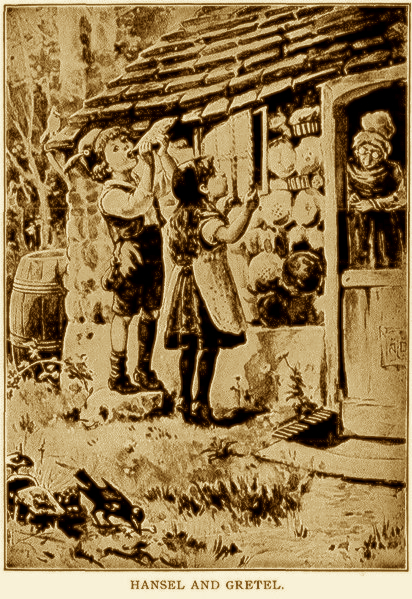



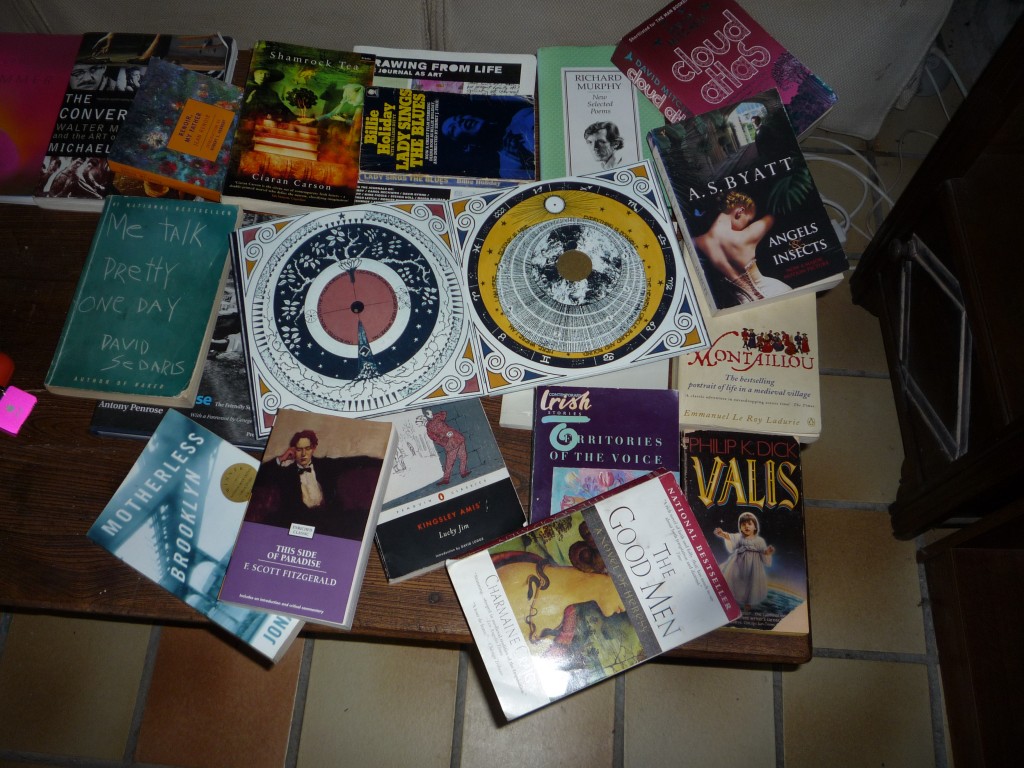










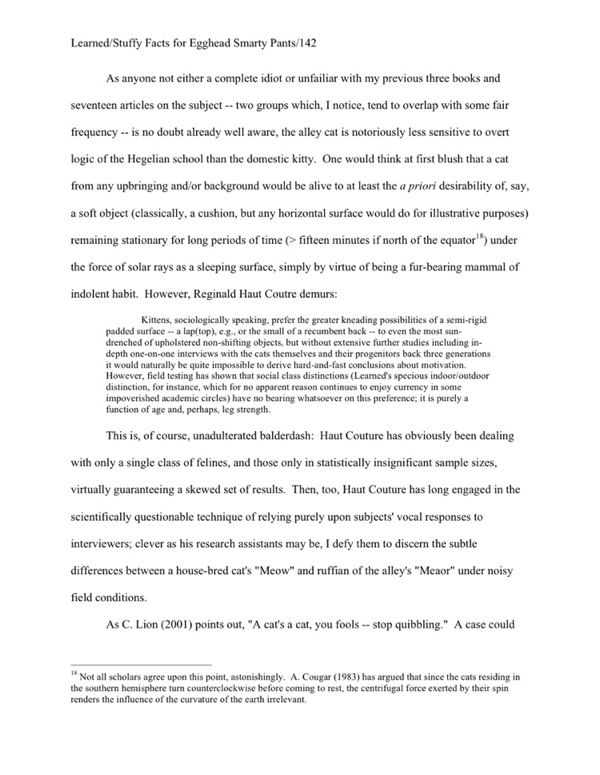

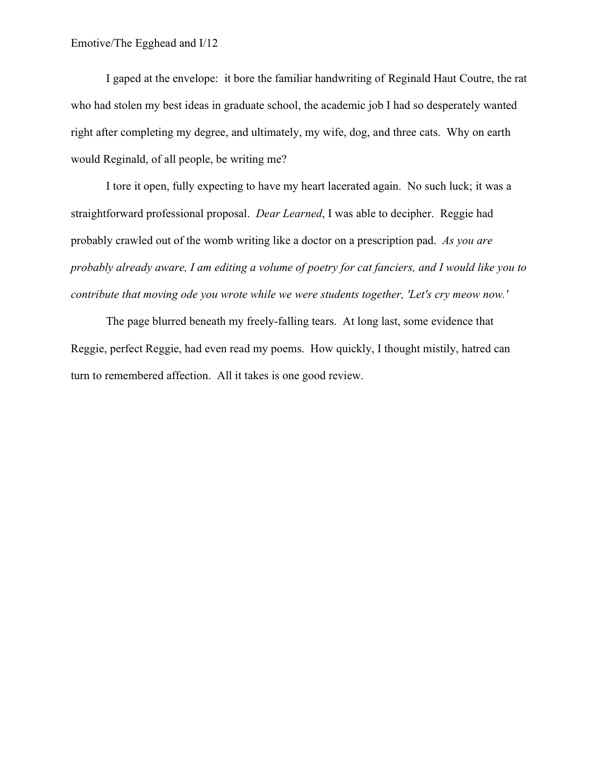

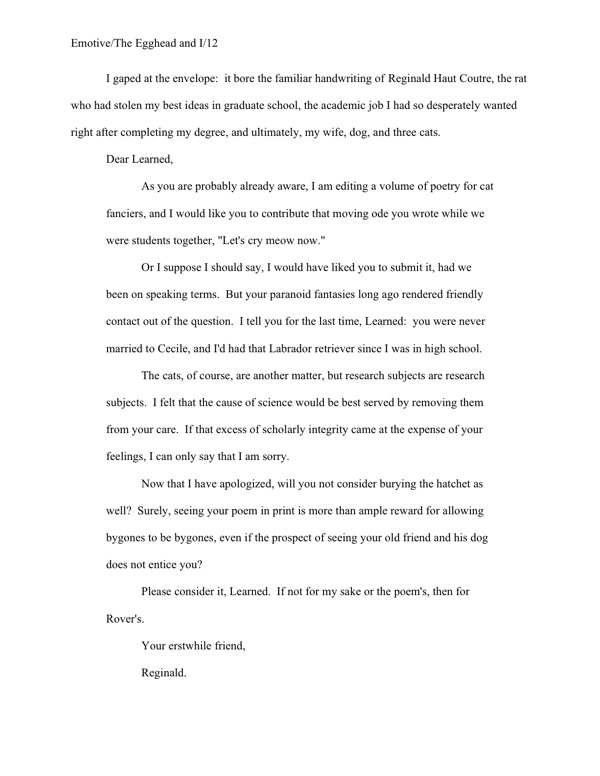

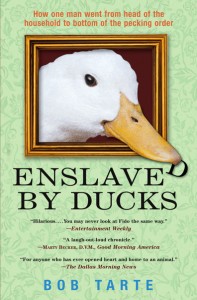 Enslaved By Ducks
Enslaved By Ducks Fowl Weather
Fowl Weather





